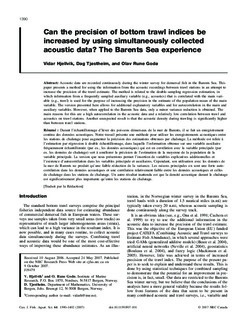| dc.contributor.author | Hjellvik, Vidar | |
| dc.contributor.author | Tjøstheim, Dag | |
| dc.contributor.author | Godø, Olav Rune | |
| dc.date.accessioned | 2008-02-21T16:28:49Z | |
| dc.date.issued | 2007-12 | |
| dc.identifier.uri | http://hdl.handle.net/11250/108282 | |
| dc.description.abstract | Acoustic data are recorded continuously during the winter survey for demersal fish in the Barents Sea. This paper presents a method for using the information from the acoustic recordings between trawl stations in an attempt to increase the precision of the trawl estimate. The method is related to the double-sampling regression estimation, in which information from a frequently sampled auxiliary variable (e.g., acoustics) that is correlated with the main variable (e.g., trawl) is used for the purpose of increasing the precision in the estimate of the population mean of the main variable. The version presented here allows for additional explanatory variables and for autocorrelation in the main and auxiliary variables. However, when applied to the Barents Sea data, only a minor variance reduction is obtained. The main reasons for this are a high autocorrelation in the acoustic data and a relatively low correlation between trawl and acoustics on trawl stations. Another unexpected result is that the acoustic density during trawling is significantly higher than between trawl stations. | |
| dc.format.extent | 994833 bytes | |
| dc.format.mimetype | application/pdf | |
| dc.language.iso | nob | en |
| dc.publisher | NRC Canada | en |
| dc.subject | acoustics | en |
| dc.subject | demersal fish | en |
| dc.subject | bunnfisk | |
| dc.subject | akustikk | |
| dc.title | Can the precision of bottom trawl indices be increased by using simultaneously collected acoustic data? The Barents Sea experience | en |
| dc.type | Journal article | en |
| dc.type | Peer reviewed | |
| dc.source.pagenumber | 1390-1402 | en |
| dc.source.volume | 64 | en |
| dc.source.journal | Canadian Journal of Fisheries and Aquatic Sciences | en |
| dc.source.issue | 10 | |
| dc.identifier.doi | http://dx.doi.org/10.1139/F07-101 | |
